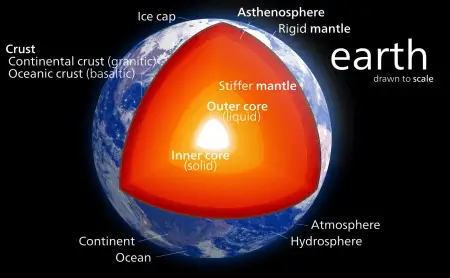Our planet is made up of four layers: the crust, mantle, outer core and inner core. The crust is the top-most layer, followed by the thickest layer, the mantle.
The innermost layer is the core, and it is composed of the outer and inner core.
This article seeks to highlight the difference between the two innermost layers of the Earth.
Summary Table
| Inner Core | Outer Core |
| Innermost layer of Earth | Surrounds the inner core |
| Solid ball of iron and nickel | Made of liquid iron and nickel |
| Has a radius of 1,220 kilometers or 768 miles | Approximately 2,300 kilometers or 1,400 miles thick |
| Temperature estimated to be about 5,400 degrees Celsius or 9,800 degrees Fahrenheit | Hottest region is about 3,730-7,730 degrees Celsius or 6,740-13,940 degrees Fahrenheit |
Definitions

How Were the Inner and Outer Cores Formed?
The Earth started out as a disc of dust and gas that orbited our sun. The dust particles began to clump together due to the forces of drag, causing the dust clumps to form rock. Scientists believe that as our planet cooled, the heavier and denser materials of the Earth sank toward the center.
At the same time, lighter materials rose towards the top, where these materials formed the surface of the Earth. Meanwhile, the heavier materials formed the inner and outer cores of the planet.
What are the Inner and Outer Cores?
The inner core is the innermost layer of the Earth, and is believed to be a solid ball composed of iron and nickel along with some light elements (e.g., oxygen, sulfur, silicon). It has an estimated radius of 1220 km (768 mi).
Seismologist Inge Lehmann was the first to discover the inner core as being solid and covered by a liquid outer core. Lehmann was able to arrive at this conclusion by studying seismic waves caused by earthquakes bouncing off the inner core’s boundary. It was suggested in 1940 that this inner core is solid iron.
It is a widely-held belief that the inner core is gradually expanding as the liquid outer core cools down and solidifies where the two layers meet. This growth is believed to be important in generating the planet’s magnetic field. In addition, scientists also believe this phenomenon indicates a homogeneous characteristic of the inner core; that is, it remains solid if it is growing into the liquid outer core. It has been suggested the inner core could also be a big iron crystal. This theory was disproved when the inner core was discovered to be not completely uniform. Recently, researchers have discovered that the inner core also contains an inner inner core. It is believed to be between 250 to 400 kilometers in diameter.
The heat of the inner core (see below) is primarily driven by the decay of radioactive elements in the Earth’s crust and mantle. These elements include uranium, thorium, and potassium. The inner core’s heat is also caused by the remaining heat from the formation of the planet and heat from the solidification of the outer core.
The inner core rotates in the same direction as the surface of the Earth; however, it rotates slightly faster. The inner core completes an extra rotation about every 1,000 years.
The boundary between the inner and outer cores is called the Lehman Seismic Discontinuity.
The outer core of the Earth is a liquid layer of iron and nickel 2,890 kilometers (1,400 miles) beneath the surface of the Earth. It stretches to about 2,300 kilometers (1,400 miles). It is estimated that the temperature of the outer core is from 4,000-8,000 K (6,740-13,940 degrees F or 3,730-7,730 degrees C) as it gets near the inner core, and 3,400-4,500 K (4,940-7,640 degrees F or 2,730-4,230 degrees C) in its outer regions.
However, as the Earth ages, it is gradually cooling. This cooling causes the liquid outer core to crystallize and become part of the solid inner core.
The entire process causes the inner core to grow about 0.039 inches (one millimeter) each year.
The constant churning of liquid iron of the outer core creates magnetic fields and electricity.
This continuous process is called the geodynamo, and it is responsible for the magnetic field surrounding our planet.
Without the Earth’s magnetic field, our atmosphere would be easily blown away by solar winds.
At some point in the future, Earth’s cores will solidify, resulting in the magnetic field ceasing to exist. That will not be good news, as the magnetic field not only keeps the Earth’s atmosphere in place, but it also protects the planet’s surface from harmful cosmic radiation. The good news is that this will not happen for several billion years.
Inner Core vs Outer Core of the Earth
Now that we have the facts, what’s the difference between the inner core and outer core of the Earth? The earth’s inner core is a solid ball of iron, nickel and other metals, while the outer core is liquid metal composed of iron and nickel as well. The temperature of the inner core is estimated to be about 5,400 degrees C or 9,800 degrees F, far beyond iron’s melting point. Intense pressure present within the inner core prevents the iron from melting.
The hottest region of the outer core is about 3,730-7,730 degrees C or 6,740-13,940 degrees F.
In terms of size, the inner core’s radius is about 1,220 kilometers (768 miles). The outer core is believed to be about 2,300 kilometers (1,400 miles) thick, and is located 2,890 kilometers (1,400 miles) beneath the surface of the Earth. The inner core is about 6,371 kilometers (3,958 miles) deep beneath the surface.





